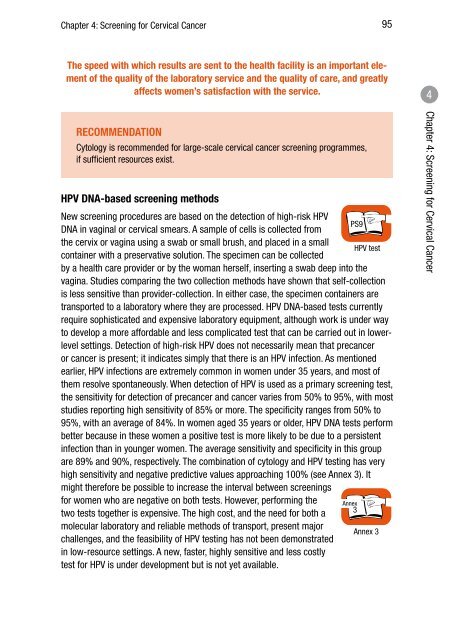CHAPTER 4: SCREENING FOR CERVICAL CANCER
CHAPTER 4: SCREENING FOR CERVICAL CANCER
CHAPTER 4: SCREENING FOR CERVICAL CANCER
You also want an ePaper? Increase the reach of your titles
YUMPU automatically turns print PDFs into web optimized ePapers that Google loves.
Chapter 4: Screening for Cervical Cancer 95The speed with which results are sent to the health facility is an important ele-ment of the quality of the laboratory service and the quality of care, and greatlyaffects women’s satisfaction with the service.4RECOMMENDATIONCytology is recommended for large-scale cervical cancer screening programmes,if sufficient resources exist.HPV DNA-based screening methodsNew screening procedures are based on the detection of high-risk HPVPS9DNA in vaginal or cervical smears. A sample of cells is collected fromthe cervix or vagina using a swab or small brush, and placed in a smallHPV testcontainer with a preservative solution. The specimen can be collectedby a health care provider or by the woman herself, inserting a swab deep into thevagina. Studies comparing the two collection methods have shown that self-collectionis less sensitive than provider-collection. In either case, the specimen containers aretransported to a laboratory where they are processed. HPV DNA-based tests currentlyrequire sophisticated and expensive laboratory equipment, although work is under wayto develop a more affordable and less complicated test that can be carried out in lowerlevelsettings. Detection of high-risk HPV does not necessarily mean that precanceror cancer is present; it indicates simply that there is an HPV infection. As mentionedearlier, HPV infections are extremely common in women under 35 years, and most ofthem resolve spontaneously. When detection of HPV is used as a primary screening test,the sensitivity for detection of precancer and cancer varies from 50% to 95%, with moststudies reporting high sensitivity of 85% or more. The specificity ranges from 50% to95%, with an average of 84%. In women aged 35 years or older, HPV DNA tests performbetter because in these women a positive test is more likely to be due to a persistentinfection than in younger women. The average sensitivity and specificity in this groupare 89% and 90%, respectively. The combination of cytology and HPV testing has veryhigh sensitivity and negative predictive values approaching 100% (see Annex 3). Itmight therefore be possible to increase the interval between screeningsfor women who are negative on both tests. However, performing the Annextwo tests together is expensive. The high cost, and the need for both a 3molecular laboratory and reliable methods of transport, present majorAnnex 3challenges, and the feasibility of HPV testing has not been demonstratedin low-resource settings. A new, faster, highly sensitive and less costlytest for HPV is under development but is not yet available.Chapter 4: Screening for Cervical Cancer
















